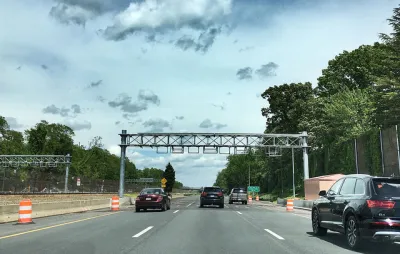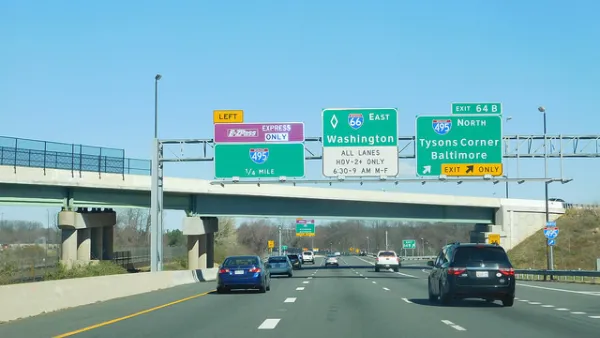The new 66 Express Lanes Inside the Beltway made headlines when one-way tolls topped $40. Max Smith of WTOP News reports how revenues are used in Northern Virginia. Bus transit and shuttles to park-and-ride lots are two of the biggest beneficiaries.

The 66 Express Lanes Inside the Beltway captured the nation's attention on day two of operation, Dec. 5, 2017, with its $40 tolls for solo-drivers during the height of the morning rush hour. According to an agreement with the Northern Virginia Transportation Commission, Virginia Department of Transportation and Virginia Department of Rail & Public Transportation, toll revenues largely benefit transit in the corridor.
With uncapped tolls and dynamic tolling, the lanes operate as one of the nation's best examples of successful congestion pricing. While electric vehicles don't get a break, carpools of two or more and motorcycles travel toll-free.
Max Smith of WTOP News reports on the projects selected to be awarded toll revenue on May 3. In a second article, Smith describes the performance in terms of speeds and tolls paid.
The Northern Virginia Transportation Commission [NVTC] is scheduled to approve $12 million in projects Thursday night including two new bus routes, improvements on three other bus routes and expanded access to park-and-ride lots. Another project included would expand Capital BikeShare around the Vienna and Dunn Loring Metro stations.
The process of selecting and funding multimodal transportation projects is described in the I-66 Commuter Choice Program. The program lists eight categories of projects that are eligible.
Smith lists all 15 projects that were selected along with their descriptions. Projects fell into three main categories:
- $7.2 million is expected to go to new or improved bus service.
- $2.6 million is slated to improve access to park and ride lots, bus stops, and Metro or VRE stations. [Access is multimodal, e.g., commuter shuttle, bike parking].
- $800,000 is meant to improve response to crashes and other incidents along the I-66 corridor.
===========================================================================================================
Performance and tolls paid
Those $40 tolls do not occur often, although they peaked at $47.00 on April 5 after a D.C. Metro failure sent commuters into their cars for the morning trip to Washington, showing the close relationship between transit, roads, and dynamic tolling, particularly when tolls are uncapped.
In a separate article also published May 1 by WTOP, Smith reports on the performance of the express lanes in terms of speeds and tolls paid for the month of March.
"The average toll paid for an individual trip eastbound in the morning dipped from $8.71 in February to $8.19 in March, and westbound in the afternoon from $4.51 to $4.46," reports Smith. "Those averages include shorter trips that are charged a fraction of the posted price for a trip on the entire corridor."
Morning commutes on I-66 itself are somewhat faster now than a year ago except between 7 a.m. and 7:30 a.m., when trip times are largely unchanged.
A year ago, the lanes operated as high occupancy vehicle (HOV) lanes. On Dec. 4, 2017, solo-occupant vehicles gained access to them legally provided they had an E-ZPass transponder so they could be tolled for distance driven. During non-commute hours, the lanes operate as general purpose lanes.
For one of those full trips in the morning, 674 drivers paid $40 or more in March.
Since tolling began Dec. 4, the average morning price paid is now $7.99, and the average afternoon price paid is $4.32. Those numbers have been rising somewhat each month following lower usage in the early months of the tolls and expanded HOV hours.
The percentage of carpoolers is significant. There were about equal numbers of carpoolers and solo-occupant, toll-paying drivers using the express lanes, with almost 13 percent of vehicles lacking E-ZPass transponders who are billed in the mail and charged penalties.
Morning commutes on I-66 itself are somewhat faster now than a year ago except between 7 a.m. and 7:30 a.m., when trip times are largely unchanged.
Hat tip to IBTTA Smart Brief.
FULL STORY: How I-66 toll money will be spent

Analysis: Cybertruck Fatality Rate Far Exceeds That of Ford Pinto
The Tesla Cybertruck was recalled seven times last year.

National Parks Layoffs Will Cause Communities to Lose Billions
Thousands of essential park workers were laid off this week, just before the busy spring break season.

Retro-silient?: America’s First “Eco-burb,” The Woodlands Turns 50
A master-planned community north of Houston offers lessons on green infrastructure and resilient design, but falls short of its founder’s lofty affordability and walkability goals.

Test News Post 1
This is a summary

Analysis: Cybertruck Fatality Rate Far Exceeds That of Ford Pinto
The Tesla Cybertruck was recalled seven times last year.

Test News Headline 46
Test for the image on the front page.
Urban Design for Planners 1: Software Tools
This six-course series explores essential urban design concepts using open source software and equips planners with the tools they need to participate fully in the urban design process.
Planning for Universal Design
Learn the tools for implementing Universal Design in planning regulations.
EMC Planning Group, Inc.
Planetizen
Planetizen
Mpact (formerly Rail~Volution)
Great Falls Development Authority, Inc.
HUDs Office of Policy Development and Research
NYU Wagner Graduate School of Public Service



























